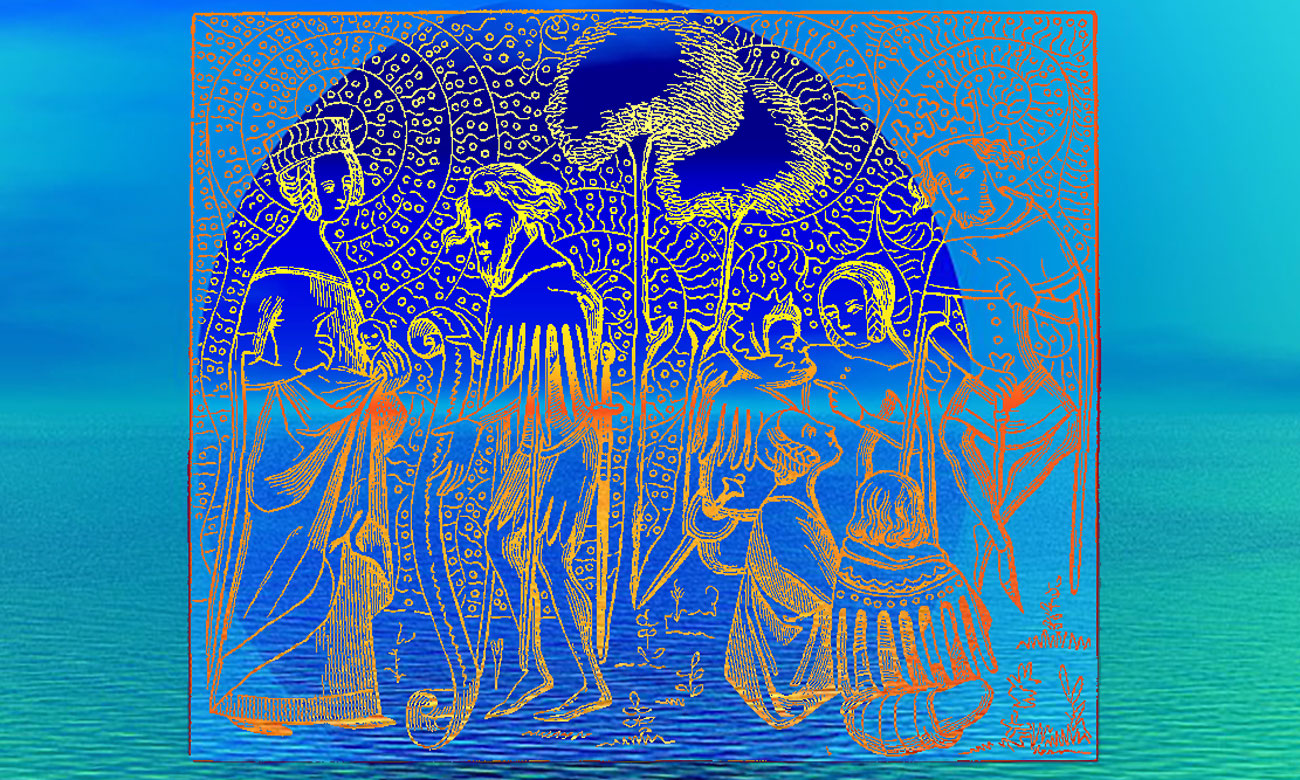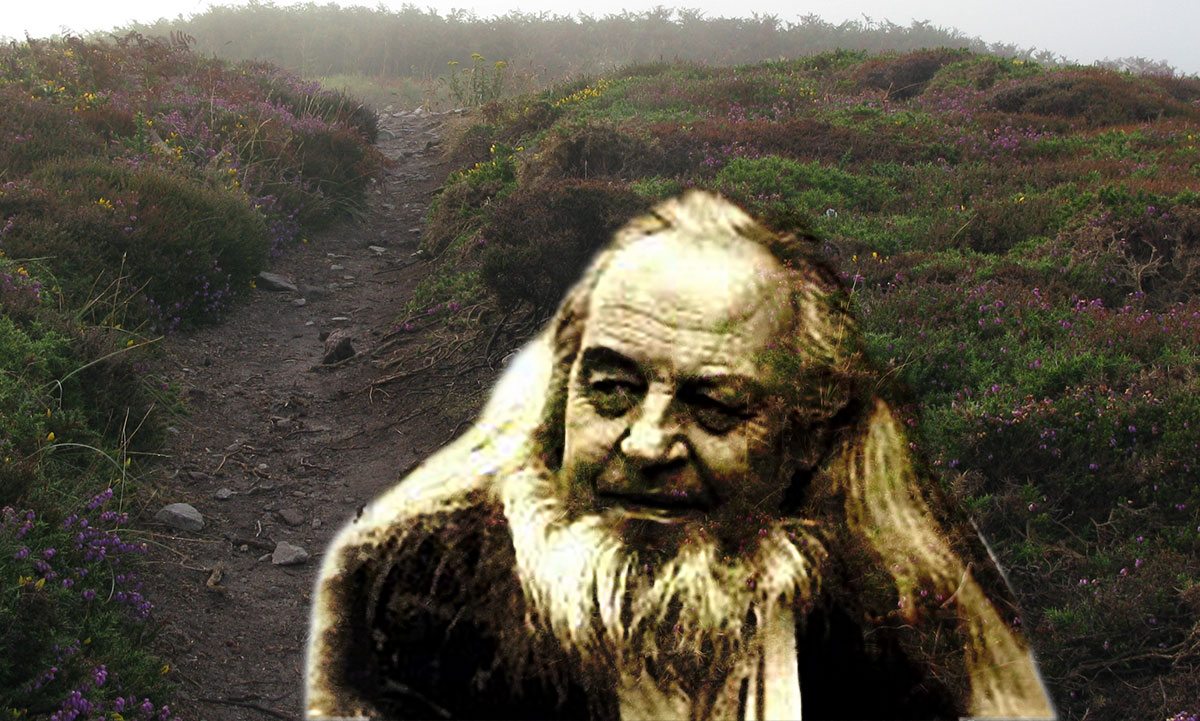
In the Middle Ages in Occitania,south of France fin’amor means a certain way of loving. It takes a lot of courtesy, infinite respect and perfect honesty between the partners. Thus will they be able to attain Joï: joy and happiness, perfect bliss. Around the troubadours and their lady of heart, a new way of life blossoms that gives love its central place.
The Origin
Fin’amor is the name given to it at the time, from the 12th to the 15th century. Nowadays, it is called courtly love. It is a complex art of love, whose characteristics vary according to the authors. Among the troubadours, the Lady is inaccessible, often married to the Lord: the fin’amor is therefore secret. And most of the time, totally platonic.
He is best known for the songs of the troubadours of the Oc country — ie the Midi of France speaking the Oc language, la langue d’Oc ; when the north spoke Oïl language, la langue d’Oïl. Medieval literature and poetry owe him much. Thus it is courteous love that launches the fashion of the novel, which must be of love. Blessed period as this end of the Middle Ages, where the softening of morals foreshadows the Renaissance. Poems, songs, novels and romances, it is good to live in love classes. This corrects the almost barbaric image of a retrograde Middle Ages, in clear decline compared to Roman mores. Mistaken bias.
Note that the word romanesque was born in the Middle Ages from the opposition between Romanesque and Latin writings. The best known are probably Tristan and Iseult and Roman de Renart.
It is the songs of troubadours that best sum up this frenzy. The oldest songs come from Aquitaine, composed by Guillaume IX, Aliénor’s grandfather. Aliénor is also known Eleanore of Guyenne — Their written traces come from the troubadours and trouvères, the trobairitz. Chrétien de Troyes, close to Aliénor, is the conductor. Arnaut-Guilhem de Marsan would be its first violin. Marsan was closely linked to Aliénor d’Aquitaine — who was his patron, as was Chrétien de Troyes. He wrote a work in langue d’Oc, very famous at the time: Ensenhamen de l’escuder, or Comportement de l’écuyer. This tutorial explains how to behave with courtesy, gallantry, dignity and respect for the laws of fine love.

A New Matriarchy
If I propose to study that very lovesee below with you, my goal is certainly not scholarship — the passion of the past drives me, not scholarship. The courteous age is a crucial and captivating episode in the history of France and Europe. The fate of women suddenly becomes more enviable. For those who belong to the aristocracy anyway. Indeed, as early as the 12th century, the woman — the Lady was said to play a central role, the most famous example of which is Eleanor of Aquitaine, the high priestess of this religion. The word is not too strong.
Fin’amor, fine love. Delicate. If we call it courteous love, it is because it is practiced in the courtyards of love. The word courtesy comes from love lessons, of course. Isn’t courtesy one of the most beautiful conquests of French chivalry?
It is also a prodigious female victory. So prodigious that it becomes excessive. Nothing exceeds the influence of the lady, who reigns over the knight’s heart and morals. He keeps his manly aptitude for combat, but a codified fight, set like a musical paper: the tournament. The jousting and passing of arms prefigure the loving jousting and the naughty passes. Turn tournaments, courteous love turns the medieval world as it turns heads and turns hearts.
The Double Queen
Aliénor d’Aquitaine, also known as Eleanore de Guyenne, born around 1122 and died on March 31 or April 1, 1204 in Poitiers, was in turn Queen of France, then Queen of England. The fate of these two countries was much more closely linked than today. Two centuries later, the terrible Hundred Years’ War bears witness to this. The crown of England then owned nearly three-quarters of France. Hence the song:
Mes amis, que reste-t-il à ce dauphin si gentil ?
Orléans, Beaugency, Notre dame de Cléry, Vendôme…
(listen to this 16th century song)
My friends, what’s left for this nice dolphin?
Orléans, Beaugency, Notre Dame de Cléry, Vendôme…
And then came Joan of Arc. But let us return to Eleanor of Guyenne, also known as Eleonore de Guyenne. If Jeanne la Lorraine enlarged the territory, Aliénor reduced it considerably. Here’s how.
Duchesse d’Aquitaine and Countess de Poitiers, she married successively the King of France Louis VII (1137), then Henri Plantagenêt (1152), future King of England Henri II. It thus overturned the balance of power by bringing its lands to one and then the other of the two sovereigns.
At the sumptuous court she holds in Aquitaine, she promotes the poetic expression of troubadours in the language of oc. From her first marriage to the Second Crusade, she played an important political role as a central figure in relations between the French and English kingdoms in the 12th century.

Lady of Heart
The Fin’amors – Distant courtly love towards an intangible person – is the inaccessible ideal of the lords of the Middle Ages. The knight, often troubadour himself, confronts his opponents in often fatal warrior tournaments. Riding his fiery steed, throwing it with his fist, the shield in the other hand, he rushes to his opponent, lord like him. They fight for the honor of their ladies, whose colors — often a scarf — adorn their spears.
The Lady is not just any woman. She belongs to a wealthy elite, the aristocracy that has ruled the country for centuries. Like Eleanor, the famous celebrant of this incredible religion, the Lady is adorned with all the virtues, the main one of which is to arouse in the heart of her suitors a devastating, inextinguishable love. Her handsome knight is ready to die of pure love for her. It is not an image: tournaments are not sport. They give death.
Fine love, that is to say platonic. Not fleshly. Idealized, absolutely unattainable, the Lady is too heavenly for flesh sin — as church people say it is prized and fanned. In the legend of Tristan and Iseult, lovers do not consume their chaste love. In the bed where they both sleep, a naked sword separates them. A sword named virtue. If one of them makes a move towards the other, he will cut himself cruelly. In the same way, the young people in love with their lady of heart will not be able to approach her within a meter. They will kneel on the ground, bowing their heads as a sign of respect and total submission. They will never be able to touch it.
The Lady is inaccessible. The love we feel for her is devotion, submission, frustration no doubt. But it allows to refine the mores, thus preluding to less brutal periods. If the war will not be eradicated, the slaughter will be.
This chosen love develops qualities of heart rare and quite characteristic of a place and an era. Europe — and first France and England, who have practised it for a long time — have been able to take advantage of it. Fine love, courteous love, pure love, beautiful love, gallant love, chaste love, naughty love, crazy love — France is as much the land of love as it is the land of wine. As the song says:
Passant par Paris, vidant la bouteille
Un de mes amis me dit à l’oreille, lon-lon-la,
Le bon vin m’endort, l’amour me réveille,
Le bon vin m’endort, l’amour me réveille encore !
(listen)
Going to Paris, sucking down the bottle
A good friend of mine whispered in my ear, hi-dee-oh,
Good wine makes me sleep, love is sweet and keep me,
Good wine makes me sleep, love is sweet and keep me up!
This is still the case, and not only in Paris. Sweet France thinks about it and devotes herself to it. Love is a forgiving child. He has the wings of an angel, a quiver and arrows that he flaunts. Would he do it in Canada? That’s not Robert Charlebois’ opinion:
Si j’avais les ailes d’un ange
J’partirais pour Québec !
(listen)
If I had the wings of an angel
I’ll go to Quebec!
But the courteous love of an unattainable Lady — often married — has served many young people for sexual initiation by developing self-control, and providing a surge of energy through the grace of sublimated sexual energy, which allows the kundalini to ascend to the higher chakras.
Love class
The inescapable Aliénor is the heart and soul of this love. And the temples where Aliénor celebrates this new cult are named Courts of Love. The Courts of Love are medieval courtly games during which, in an organization modelled on the judicial institution, questions of law and love were discussed. (source)
Don’t look for courtesans, let alone courtesans: this love touches the sublime, these courts are more beautiful than the court of a monarch and more glamorous than the courts of justice — from which they draw for the wording of rules and laws of love. Its doctrine and rules are strict as those of a high court of justice.
Nevertheless, all sexuality is not absent. If we do not consume this love, the sexual energy it develops in the heart, body and spirit has a name: temperance. So from abstinence comes moderation. From inviolable respect comes self-control. The adolescent finds a loving orientation that makes him worthy to love and beloved : he stops the world. The virile ideal of brutality, the often bestial cruelty that we lend to Europe castles and armor finds here its happy counterpart.

The End of Knights
In the 15th century, when chivalry came to an end, his last avatar, the Love Court, appeared. It still bears the name, but the mind too thin has been lost. The Court in Love is a company founded in 1401 at the initiative of the dukes Louis de Bourbon and Philippe de Bourgogne and placed under the patronage of the King of France Charles VI. It brought together nobles, ecclesiastics, bourgeois and humanists, united in the celebration of ladies and the sentiments they inspire, in the form of poetry contests and songs and oratorical jousts. (source)
Bourgeois, ecclesiastics, humanists… We are far from the troubadours knights of previous centuries. Decadence is a sign of an end to fashion. The beautiful Middle Ages, in fact, live its last decades. The revival begins in Italy with the Quatrocento,15th century paradise of painters, sculptors, architects, gardeners and other arts of pleasure.
The refinement of the Renaissance bears within it the indelible mark of courteous love. Refinement of the Fin’amor. It starts in Italy and will flourish in France as soon as this bloody war against the English ends. This was not coming soon. As its name suggests, it lasted a hundred years and without Joan of Arc, it would last even longer.
Bard and Troubadour
If the troubadour comes from Aquitaine, the bard is Celtic. I knew the last of the bards, Glenmor, when he sang in the bistros of Armor. I was fifteen years old. Soon after, marked by this great man, I became a folk singer. My only stage — almost — has been the American Cathedral in Paris, avenue George V. It was called the American church as well. I don’t think Glenmor ever performed there. We sang there with Pete Seeger,once only! Graeme Allwright, Steve Waring and Hugues Aufray. The jousts were only musical. What relation to courteous love? My short career as a folk singer has no connexion, I daresay. My very point is to introduce Glenmor the Breton bard, and one of his best songs. That’s done.
That Very Love
By gliding life on the far shore
You make the way a sweet job
Holding the heart of joy and sharing
You make happiness a beautiful path
This love, you see my love, don’t get drunk
Giving hands to others who swim
To puke together laughter and life
Will be all merry ship crew
The foam has its flowers, the earth has its sounds
This world, you see, my dear, don’t cry
Strolling here and there, the dawn is reborn
From the sky in the morning the colors are played
The world is created, the night is hidden
The fires of the sunset have sweet splendors
This sun, you see, my dear, does not go out
We sail together, we are not wise
Love has its places, the heart has its rights
Our crazy years are over
We were shepherds, love makes us kings
This love, you see, my love, does not die
(listen)
Love has its places, the heart has its rights, sings Glenmor the Breton bard of my childhood. I would even say more: love has its gods, the heart has its laws. The gods of love are the goddesses of the court of love and their elect. The laws of the heart are the rules you sing.

Why am I telling you all this? For the future. There is a second part coming soon. Don’t miss it. It can change the way you feel and believe. It can change the way you love. That’s the point.
Forthcoming: The alchemical couple


